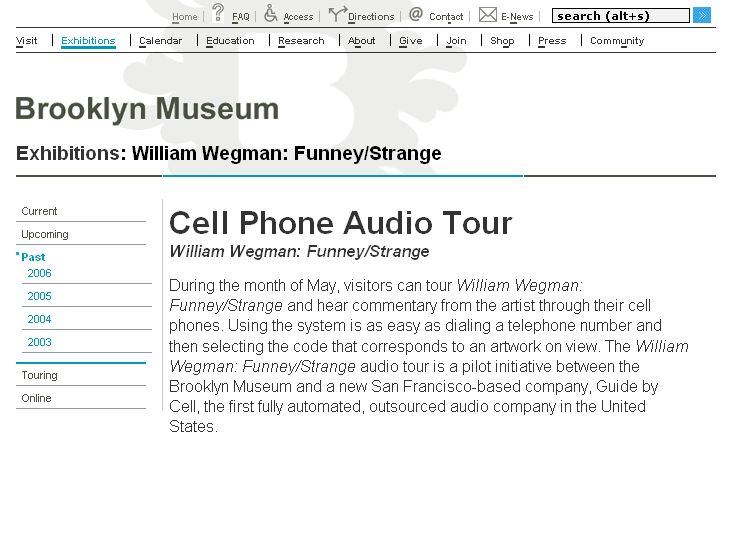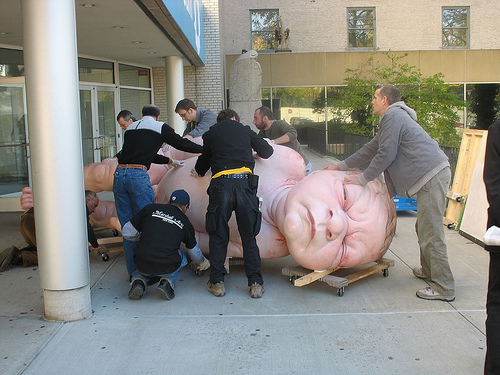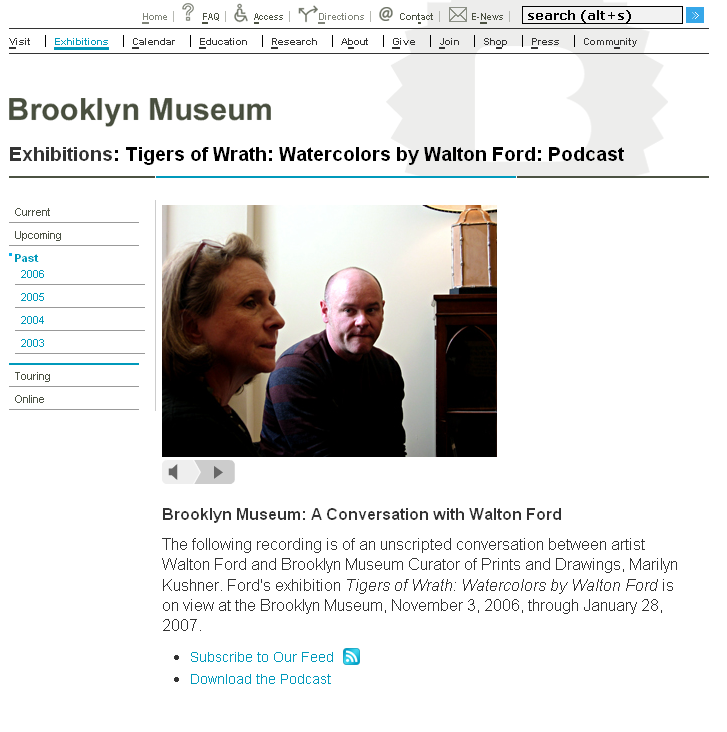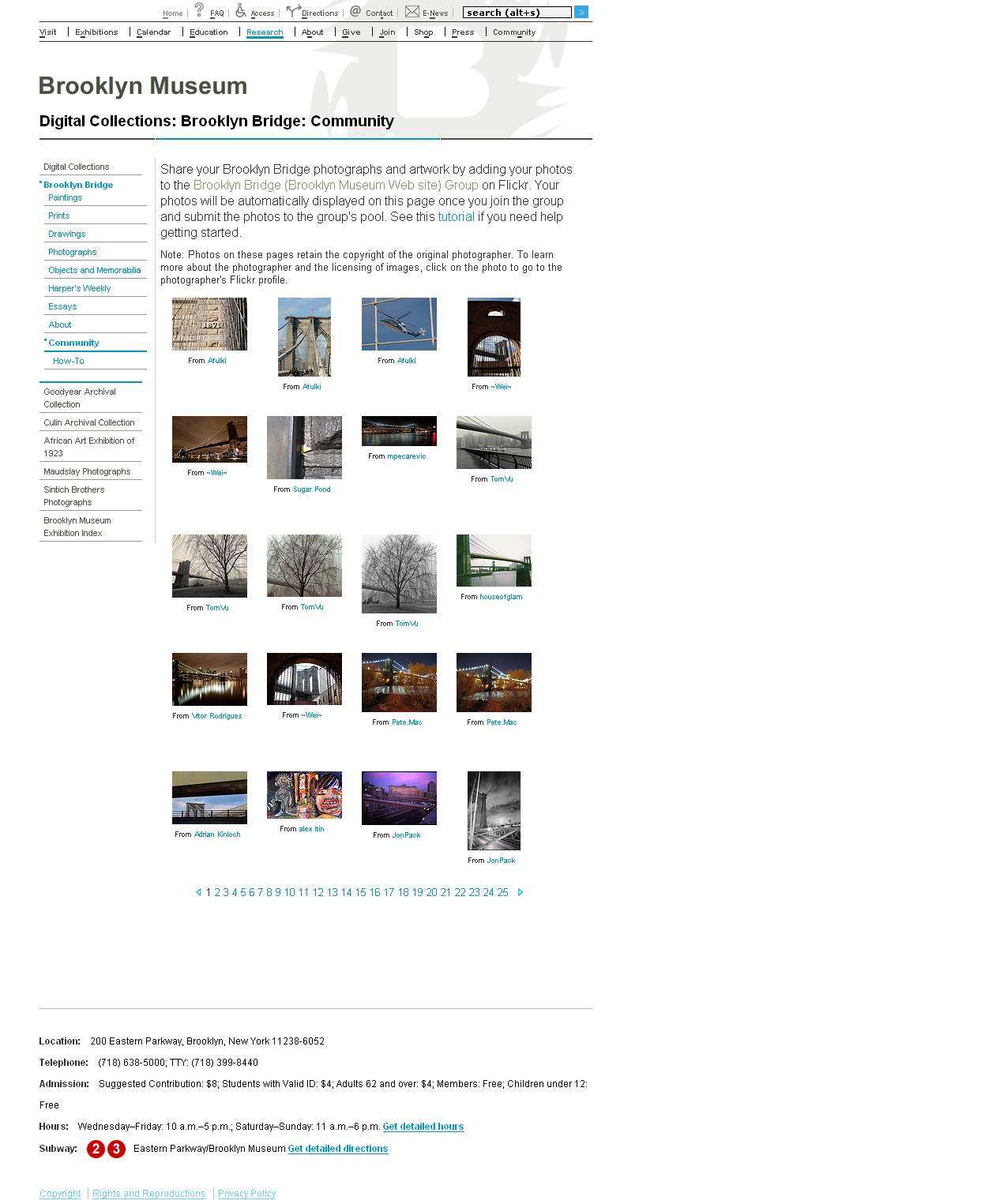Nicole J. Caruth and Shelley Bernstein, Brooklyn Museum, USA
Abstract
The mission of the Brooklyn Museum is to act as a bridge between the rich artistic heritage of world cultures, as embodied in its collections, and the unique experience of each visitor. Dedicated to the primacy of the visitor experience, committed to excellence in every aspect of its collections and programs, and drawing on both new and traditional tools of communication, interpretation, and presentation, the Museum aims to serve its diverse public as a dynamic, innovative, and welcoming center for learning through the visual arts.
Keywords: Web 2.0, community, Brooklyn, Graffiti, flickr, MySpace, interpretive materials
The mission of the Brooklyn Museum carries forth from our Director, Arnold Lehman, to our exhibitions, programs, and services, and through our Web site. Conscious of our community-oriented mission and the diversity of our audience, as well as that of the greater metropolitan area, in 2006 we set out to further engage our current on-line audiences and simultaneously build an interactive Web community. The Interpretive Materials Manager and the Manager of Information Systems have worked together closely to utilize Web 2.0 sites and services not only to reach out to our young audience demographic, but also to provide interactive learning tools and relevant forms of interpretation. Our efforts have for the most part been successful, despite a very modest budget. This paper discusses the challenges, successes, and lessons of our various Web 2.0 projects in 2006-7, involving but not limited to Blogger, Flickr, MySpace, Facebook, Blip.tv, YouTube, Cell Phone Audio Tours, and podcasts/mp3 downloads.
As one example, we will review lessons learned from the Brooklyn Museum’s summer exhibition, Graffiti, on view June 30–September 6, 2006. Graffiti utilized sites such as Flickr and MySpace to highlight the exhibition itself as well as its in-gallery and on-line interactive projects (see “Multimedia Highlights” at www.brooklynmuseum.org/exhibitions/graffiti/ for examples).
Building an On-line Community at the Brooklyn Museum: A Timeline
In 2006, the Manager of Information Systems and the Interpretive Materials Manager somewhat inadvertently began to align what had been detached efforts in order to create a more dynamic Web site, provide interactive exhibition experiences on-line, and extend the Museum visit. The narrative that follows discusses the various pilot projects, from spring 2006 to the present, in which we employed Web 2.0 to support the Museum’s community-oriented and visitor-friendly mission, fostering the general public’s interaction and dialogue with the institution. Of course we recognize the many public and scholarly conversations currently taking place about on-line communities, the commercialization of the Web, and the “I”/”U” phenomenon of the Internet generation, characterized by the rise of the Internet, rapid communication, and informality, both in and out of a museum context. But our narrative does not address them directly. Instead, we present our work as it unfolded - organically, seasonally, and sometimes improvisationally. We hope that this chronological ‘timeline’ presentation will encourage other institutions in similar situations and/or with similar goals to look at their exhibition schedules and find an occasion to begin participating in these community-generated arenas. “The era of control is over: You can either stay in the bunker, or you can try to participate. And to not participate is criminal” (Dilworth 2006).In the beginning, we faced a number of challenges and concerns.
Challenges
Museum mission: Though the Museum’s community-based mission had somewhat different ramifications for our distinct institutional roles, essentially both of us faced the same question. How do we translate that mission to our Web site and make it relevant and exciting for our audiences?
Audience: A series of visitor surveys from 2002 on had revealed that the majority of our audience were young (55% under the age 45), highly educated (72% had undergraduate degrees or higher), and computer-savvy (8 out of 10 had access to the Internet). The same surveys indicated that these younger visitors consumed content faster - that is, they visited more exhibitions in a shorter period of time - yet wanted to get more out of their visits.
Web Migration: In early spring 2006, the Brooklyn Museum’s Web site was going through a complicated four-month technical migration; this meant freezing all new development until that transition was complete. This circumstance limited what we were able to accomplish for our immediate exhibitions.
Limited Staff: During this period, there was not enough Information Systems programming staff to keep up with institutional demands and other apparent needs. At the same time, the Museum had (and has) only one Interpretive Materials person, carrying responsibility for both in-gallery and on-line interpretive projects.
Funding: Limited funding to develop programming and/or increase the staff was an issue for us, as it is for many museums.
Staff Education: The Museum’s Director, Arnold Lehman, was very supportive of our efforts and recognized how Web 2.0 initiatives advanced the Museum’s mission. Still, it was necessary to educate a number of others on staff about these platforms and how they could be used effectively and efficiently.
Limited Communication: We are two people within a staff of 350 and reside in two different wings, and two different departments, of the Museum. As a result, contact between us was at first minimal and our efforts not always unified.
Progress
Despite these issues, things began to come together: at the same time that our Web site was migrating and the Information Systems Manager (Shelley) was thinking about ways to make a more dynamic and interactive Web site, the Interpretive Materials Manager (Nicole) was considering new ways not only to keep a digital record of our gallery interactives, but also to make them accessible and relevant to our audiences on-line (whether as their sole form of visitation or as an extension of their physical visits to the Museum).
Then, with the IS department’s discovery of Blip.tv and Flickr and a growing sense of IM’s objectives, we recognized that our goals were actually parallel: we realized that Web 2.0 communities allowed us to provide interesting content and interpretation on-line - letting us operate within the constraints just mentioned while nonetheless reaching for the institution’s overarching goals.
Waking Up with Wegman: Spring 2006
Our first foray into the Web 2.0 world occurred during our exhibition William Wegman: Funney/Strange (March 10-May 28, 2006). With the artist’s fabulous video titled Museum on view in our lobby, we wanted to find a way to provide that content for our audience on-line. Why? It was the basic impulse of wanting to share - the impetus that drives most Web 2.0 sites. With no way to program video into our Web site at the time, we found that with an upload to Blip.tv and a simple link, we could indeed provide the content quickly and easily. With Blip.tv’s ability to track views and their comment-posting feature, we could immediately see that video was fairly popular on the site and that our visitors wanted to express themselves about it.
Audience: Suddenly, we had two audiences: first, our regular visitors; and, second, a substantial new audience from Blip.tv, made up of people viewing our content on-line even though they might never have come to our homepage otherwise.
Community happened instantly, and our visitors were giving us direct feedback on the video by posting comments.
Simplicity: Keeping things simple (an upload plus a link) made our work - and visitor navigation - quick and easy.
Fig 1: William Wegman Cell Phone Audio Tour page. http://www.brooklynmuseum.org/exhibitions/william_wegman /william_wegman_audio_tour.php
The Interpretive Materials package for the Wegman exhibition included our pilot cell phone audio tour in which visitors could hear William Wegman and/or a Brooklyn Museum curator talk about a selection of works on view. Guide BY Cell, a San Francisco-based company, was offering a free 30-day trial, and so we developed this audio component to run for the last four weeks of the exhibition. The cell phone tour came at a time when the IM Manager was reevaluating the institution’s more traditional audio tours and researching the new options that the market had to offer. In that research, the cellular phone seemed to be the one device that significantly reduced (though perhaps did not completely eliminate) the generational divide, as cell ownership ran the gamut from pre-teens to older adults. In our pilot program, we discovered that the pickup rate for the cell phone tour tripled from our usual audio tour numbers. We will return to this subject later in our narrative, to discuss the subsequent integration of cell phone tours into our Web site and Web 2.0 ventures. This integration could not be completely foreseen at the time of the Wegman show.
Growing with GRAFFITI: Summer 2006
Struck by the positive visitor and staff response to the Wegman video and cell phone audio pilot, we began to evaluate various Web 2.0 sites to see how they could help us create more interactive exhibition content, within our limitations.
The Graffiti Mural
Fig 2: The Brooklyn Museum’s “Graffiti Mural” wall prior to visitor participation
Fig 3: A Brooklyn Museum visitor contributing to the “Graffiti Mural”
Fig 4: The Brooklyn Museum’s “Graffiti Mural” following weeks of visitor participation
The Interpretive Materials plan for Graffiti invited museum-goers to ‘tag’ two designated walls within the exhibition space. This wall was the tipping point for our collaboration, going forward, and the catalyst for building a dynamic interactive Web site. For, anticipating that this wall would change significantly during the exhibition’s eight-week run, the IM manager planned to take the activity one step further - inviting visitors to track the progress of the “Museum Mural” on our Web site. Again, the idea was at hand before we knew quite how to bring it to fruition. At the suggestion of members of the IS department, we employed the popular photo-sharing site Flickr, and for $24 a year (the cost of a Flickr pro account), we could upload new digital images, weekly, taken off the wall. Through the use of Flickr, we realized that we could provide this content/activity quickly and efficiently, and without the arduous in-house development of our own program. Caruth/Bernstein_Link: http://www.flickr.com/photos/brooklyn_museum/sets/72157594171809720/
The “Graffiti in Brooklyn” Archive
Fig 5: A public work by the Brooklyn-based street artist Elbow-Toe
Now that we had our Flickr account, we started to think about other ways it could be leveraged. We decided to create another project in which we asked visitors to submit images of already-existing street art from their local Brooklyn neighborhoods. Photos e-mailed to the Museum were posted to our Flickr account throughout the run of the exhibition. In the end, the community established the first-ever Museum archive of local street artists. Caruth/Bernstein_Link: http://www.flickr.com/photos/brooklyn_museum/sets/72157594168613271/
Virtual Graffiti
Fig 6: Web Page for the Brooklyn Museum’s “Virtual Graffiti” Project. http://www.brooklynmuseum.org/exhibitions/graffiti/drawing_tool/ drawing_tool_template/drawing_gallery.php
Having a plan for in-gallery tagging, we started to ask ourselves if we could provide a way for Web visitors to do the same thing - create a graffiti drawing, but virtually, via the Web. We soon remembered that there was an on-line drawing tool as part of the Museum’s award-winning teen site From Street to Studio, created for the exhibition Basquiat the previous year. In order to add this to our multimedia package, we hired the original development team of the Basquiat site (EduWeb) to repurpose the same tool in a generic form.
Fig 7: Screenshot of the Brooklyn Museum’s on-line drawing tool.
With this drawing tool, visitors to the Graffiti exhibition page were able to create on-line work using a virtual spray can, marker, pencil, or pen and submit it to an on-line gallery for others to see. The re-engineering of the drawing tool cost a fraction of what new development would have, and now that this tool has been generalized, we can use it over and over again for any suitable exhibition. Advancing the idea of Museum accessibility, the drawing tool provided a way for visitors to make their mark even if they couldn’t come to the Museum in person. Many submissions came in, both from local Brooklynites and a range of international contributors.
Podcasting

Fig 8: The Brooklyn Museum Web Page for Graffiti related podcasts. http://www.brooklynmuseum.org/exhibitions/graffiti/podcast.php
With the digital equipment that we had purchased to record William Wegman for the cell phone audio tour, we partnered with the Museum’s Adult Programs office to record exhibiting artists and local street artists, live, as they led tours through the exhibition during our popular Target First Saturday events. (First Saturday is a series of Museum programs taking place on the first Saturday of every month; it includes artist talks, films, dance lessons, live bands or DJs, and more, ending with a two-hour dance party.) These recordings launched the Museum’s podcast series. Because the recordings were live, we felt that these podcasts spoke to the spirit of spontaneity which underlies our working style, and which is also seen on a First Saturday, where recent attendance has averaged 20,000 people.
MySpace
In addition to promoting the Graffiti exhibition on our own Web site, we got the word out through our MySpace page. Interestingly, one of the local street artists, Ellis G., who was recorded for our podcast series, had a popular MySpace presence. With Ellis’s help on MySpace, the Museum was able to gain good word-of-mouth about the show and publicize the gallery talks and podcast series. Along the way, Ellis helped the Museum make many MySpace friends.
At the close of GRAFFITI:
There were 35,314 photo-set views (The ‘Museum Mural’ was viewed 12,488 times; Graffiti in Brooklyn was viewed 12,376)
- 913 photographs were submitted to the Graffiti in Brooklyn archive
- 1,338 virtual drawings were submitted
- There were 1,000 downloads of our three cumulative podcasts
- The Museum’s MySpace page had over 3,000 friends.
The plan was a success in terms of sheer numbers, and an even bigger success in terms of mission. We had discovered that community on the Web didn’t necessarily mean programming on our own site. On the contrary, seeking out our audience in their own Web communities (Flickr, MySpace, Blip.tv,) was even more powerful. After all, why should we expect them to come to us?
Flowing into Fall 2006
After Graffiti, we continued to fine-tune our Web 2.0 profiles, exploring how we could utilize them with each new exhibition and give our visitors various methods of interpretation for each.
Annie Leibovitz: A Photographer’s Life, 1990-2005
Fig 9: Photographer Annie Leibovitz at the opening of Annie Leibovitz: A Photographer’s Life, 1990-2005 at the Brooklyn Museum
Fig 10: Patti Smith performing at the opening of Annie Leibovitz: A Photographer’s Life, 1990-2005 at the Brooklyn Museum
With the Annie Leibovitz show, we were able to translate the excitement surrounding the celebrity photographer by providing images of events such as the Museum’s press conference and the opening reception (at which rocker Patti Smith performed) on Flickr and MySpace. We also podcast an interview with the artist about the exhibition and its accompanying book.
Ron Mueck
Fig 11: Ron Mueck and his assistant Charlie Clarke work with Brooklyn Museum staff to install the exhibition Ron Mueck on view at the Brooklyn Museum, November 3, 2006–February 4, 2007. http://www.brooklynmuseum.org/exhibitions/ron_mueck/
Fig 12: Ron Mueck and his assistant Charlie Clarke work with Brooklyn Museum staff to install the exhibition Ron Mueck on view at the Brooklyn Museum, November 3, 2006–February 4, 2007. http://www.brooklynmuseum.org/exhibitions/ron_mueck/
The interpretation of scale is fundamental to Ron Mueck’s sculpture, and therefore it is essential to give the visitor a direct experience of the actual work on view. By creating a Flickr slideshow that took our visitors behind the scenes of installing the exhibition, we were better able to translate the sense of the works’ scale, capturing images of art handlers, the artist, and his assistant moving around his larger-than-life Girl and much smaller Spooning Couple.
As with William Wegman, this exhibition included a wonderful video about the artist’s process (courtesy of the National Gallery, London). We hosted a short clip of this significant resource on our Web site, and then uploaded the full 30-minute video to Blip.tv, where it has been viewed more than 8,000 times.
Fig 13: Ron Mueck Q&A page. http://www.brooklynmuseum.org/exhibitions/ron_mueck/qa.php
For the Mueck exhibition, we developed an on-line Q&A with the artist, a new multimedia highlight. For this we only needed to set up an e-mail address to which visitors could submit questions for the artist. After the submission deadline, all comments were gathered and e-mailed to the artist for response.
Tigers of Wrath: Watercolors by Walton Ford
Fig 14: Walton Ford podcast page. http://www.brooklynmuseum.org/exhibitions/tigers_of_wrath/podcast.php
A podcast was created for Tigers of Wrath, but with a slightly different interpretive purpose from the others. Made directly with the artist, the podcast was more than a cool highlight or nice addition: it was essential, since the installation called for minimal interpretation in the conventional form of printed didactic materials.
Bringing Community Home: Winter/Spring 2007
Fig 15: Brooklyn Museum Community home page. http://www.brooklynmuseum.org/community/
By this point, we had not only received the continued support of the Museum Director, but had also garnered interest from curators, educators, and others on staff about future possibilities, and had extended that excitement to the Board of Trustees. As a result, we now felt that was time to bring community home. Having now developed a backbone of various Web 2.0 ventures, we gathered and combined them into one area on the Brooklyn Museum’s Web site and called it ‘Community.’ The move allowed for more visible Web participation and permitted the unification of our two on-line audiences: the Web 2.0 communities and our general Brooklyn Museum Web site visitors.
In addition to this special area, we are working to integrate community features more directly into all areas of the Web site. For example, when putting the Museum’s collection of Brooklyn Bridge-related materials on-line, we also created a community area in which visitors can share their own photos and artworks of our community’s iconic bridge. By providing e-mail addresses for feedback when we produce such Web projects, we are able to communicate with our visitors directly. Our commitment to community on the Web site will continue to evolve with each new exhibition and as we keep abreast of new developments in Web 2.0.
Fig 16: Brooklyn Bridge Collection Web page with Community presence as a component of the project. http://www.brooklynmuseum.org/research/digital-collections/brooklynbridge/
Fig 17: Brooklyn Bridge Collection Web page with Flickr-driven Community component. http://www.brooklynmuseum.org/research/digital-collections/brooklynbridge/community/

Fig 18: Brooklyn Bridge Collection Web page email address welcoming comments on the project. http://www.brooklynmuseum.org/research/digital-collections/brooklynbridge/about/
To take community one step further, we will deploy cell phone audio tours at the Museum in March 2007. These tours enable us to integrate some of our Web efforts into the physical exhibition and gallery experience by assigning a simple number code to related podcasts in our ever-growing series. Our podcasts therefore become accessible to anyone who has a cell phone (a more widespread device than the iPod or other mp3 player), and visitors won’t have to remember to download at home prior to their visits. We also attach importance to the ‘community-friendliness’ of this device and system which extends our ability to gather feedback from visitors; they are encouraged to key in #1 and record their comments about an exhibition, an object, and/or the general audio tour itself. These recordings can then be selectively transferred to the tour, in this way making the community voice part of everyone’s experience and interpretation - a myriad of voices. With the recent release of the iPhone and similar technologies, the future of cell phones as part and parcel of Web 2.0 technology appears assured.
Conclusion: Our Advice and What We’ve Learned
- Commit and respond. Remember, these are communities, and to be a good community member, you need to participate. That means reading comments, posting responses, joining groups, and providing a steady stream of fresh content.
- Know your audience. Google yourself and find out what people are saying about your institution and its Web presence. Create surveys, if you can. Even the quick and dirty can be extremely useful.
- Pilot and evaluate. It’s a good idea to pilot and then evaluate before making any large up-front investments or commitments. The formative stage is the time when you can begin to gauge what ‘community’ really means for your institution.
- Success is determined by audience participation. If your audience is participating, your success can be measured in word-of-mouth.
- Community first and foremost, marketing second. If you make a commitment to the community and provide worthwhile content, marketing will follow naturally. If you are there just to advertise, you are not being a good community member.
- Interpretive materials on the Web further the goals of both the exhibition and the institution and are as valuable as any wall label or text panel.
- To build an on-line community, you really can start small. Flickr is free, if you don't do a lot of uploading (a pro account is just $24 a year). MySpace, YouTube, Facebook, and so on are all free, too. Yes, you need a camera, but doesn’t almost everybody have one?
- The community’s voice can be louder than the museum’s, and that can be a good thing. Be prepared for both the good comments and the bad, and be open to constructive criticism. Listen to your audience. It’s worth the effort - and the comments (good or bad) are more valuable than you could ever imagine.
References
Dilworth, Ed (2006). Wired Magazine. December 2006
Cite as:
Caruth, N. and S. Bernstein, Building an On-line Community at the Brooklyn Museum: A Timeline, in J. Trant and D. Bearman (eds.). Museums and the Web 2007: Proceedings, Toronto: Archives & Museum Informatics, published March 1, 2007 Consulted http://www.archimuse.com/mw2007/papers/caruth/caruth.html
Editorial Note
















